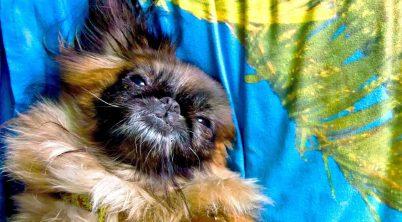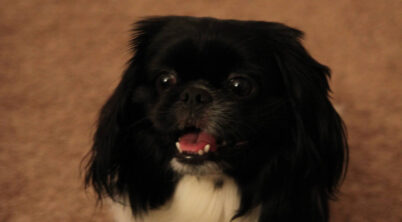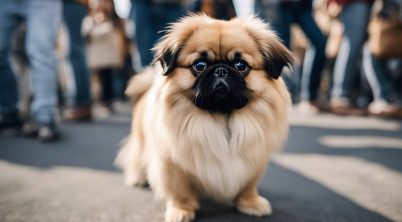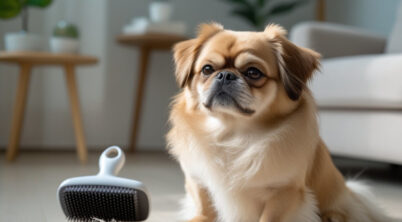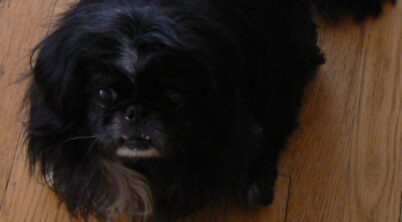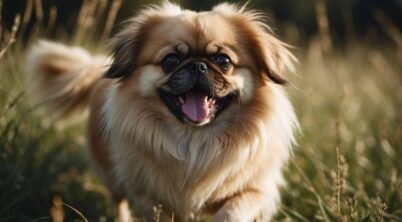The Pekingese is a breed with a storied history rooted in the palaces of ancient China. Originally bred to be companions to Chinese royalty, these small, lion-like dogs have been revered for centuries. Their long, flowing coats, flat faces, and bold demeanor are characteristics that have historically set them apart as a distinct and highly-valued breed.
In recent years, breeding practices aimed at accentuating these distinctive features have led to growing concerns over the health and well-being of the Pekingese. Selective breeding for extreme physical traits, a practice known as ‘qualzucht,’ has resulted in a prevalence of health issues within the breed. These health issues are often related to their brachycephalic nature, which is characterized by their short muzzles and flattened faces.
The modern Pekingese showcases extreme examples of brachycephaly, accompanied by protruding eyes and dense fur, which have become points of contention among animal welfare advocates and breeders. While breed enthusiasts value the unique appearance that aligns with the breed’s historical image, the health implications of such selective breeding practices raise ethical questions about the breed’s future and the responsibilities of breeders and owners in preserving the well-being of these cherished dogs.
Table of Contents
Pekingese Qualzucht
The term Qualzucht, of German origin, translates to “torture breeding” and refers to the practice of breeding animals in a way that promotes physical traits causing them discomfort, pain, or health issues. In the context of the Pekingese, a toy dog breed originating from China, Qualzucht specially denotes breeding practices that might exacerbate the breed’s predisposition to certain health problems.
The Pekingese possesses distinctive features, such as a flat face and short nose––traits sometimes attributed to intense selective breeding. This selective process can lead to respiratory difficulties, known medically as Brachycephalic Obstructive Airway Syndrome (BOAS).
| Health Concern | Description |
|---|---|
| Respiratory | Brachycephalic breeds struggle with obstructed airways, leading to labored breathing. |
| Skin | Deep facial folds may result in skin infections. |
| Eye | Prominent eyes are prone to ulcers and other issues. |
Advocates for animal welfare often criticize the Qualzucht of Pekingese, suggesting that the breed’s health is compromised for aesthetic ideals. Legislation in some regions aims to discourage such breeding practices by imposing standards prioritizing the well-being of the dogs.
Responsible breeders focus on health and temperament rather than exaggerated features. Potential Pekingese owners are strongly urged to seek reputable breeders who prioritize the dogs’ health above aesthetics, to ensure a healthy, happy Pekingese.
Breed Overview
The Pekingese is an ancient toy breed that originated in China, cherished for centuries by Chinese royalty. This section delves into the breed’s history, unique physical traits, grooming needs, health considerations, and behavioral characteristics.
Origins and History
The Pekingese breed has a storied past that traces back to Ancient China, specifically in the region of Beijing. They were considered so precious that they were part of the imperial family and often referred to as “lion dogs” due to their resemblance to Chinese guardian lions. The breed was introduced to the Western world after the Second Opium War when they were brought to England; a notable gift was made to Queen Victoria.
Physical Characteristics
Size: The Pekingese is a small dog with a typical weight up to 14 pounds and height ranging from 6 to 9 inches at the shoulder. Appearance: They possess a distinctive “rolling gait” and are known for their flat face or brachycephaly, a trait that breeders should be cautious with due to health concerns.
Color and Grooming
Their coat comes in various color variations including black, white, red, sable, gold, blue, and cream. Due to their long and dense fur, grooming is essential; options like the “puppy cut” are popular to minimize shedding.
Health and Wellbeing
Life expectancy for a Pekingese is typically between 12-15 years. However, the breed is prone to certain health issues, such as Progressive Retinal Atrophy, breathing problems due to their short noses, and Distichiasis. Regular check-ups with a veterinarian are vital for maintaining their health and wellbeing.
Behavioral Traits
Behavior: Pekingese dogs are known to be intelligent, affectionate, and loyal companions. While their activity levels are not as high as other breeds, they still enjoy regular exercise to prevent obesity, which can exacerbate breathing difficulties. They also have a reputation as good watchdogs, alert and vocal despite their size.
Cultural and Historical Significance
The Pekingese has served as a cultural icon and a symbol of royal luxury for millennia, with its lineage tracing back to Ancient China. This toy dog was more than a pet; it was an emblem of status and heritage.
Royal Companion
Historically, the Pekingese was bred to serve as a companion to the ruling classes in Ancient China. Known in Chinese as “Palasthunde” or dogs of the palace, these dogs garnered the affection of Chinese emperors for their lion-like appearance, which was revered in Buddhist culture. They were so cherished that they often resided in the imperial sleeves, a testament to their miniature size and significance. This practice reflected the Pekingese’s role in Chinese cultural history, embodying the opulence and sacredness of the imperial court.
Western Influence
The Pekingese breed was introduced to the Western world following the Second Opium War. During the looting of the Summer Palace in 1860, British and French soldiers discovered the breed and brought them to England, among them was a dog that was presented to Queen Victoria, effectively marking the breed’s entry into Europe. This event propelled the Pekingese into the global arena and solidified its historical significance. However, the desire to maintain its unique qualities led to instances of Pekingese Qualzucht, or breeding with extreme selection for aesthetic traits, sometimes at the cost of the dogs’ health. In more recent history, this has raised ethical concerns over the breeding practices employed to preserve the breed’s distinctive characteristics.
Ethical Breeding Practices
When breeding Pekingese dogs, strategies should focus on the welfare of the animals, actively working against Qualzucht—breeding practices that can lead to health problems—and align with regulatory standards for animal welfare, such as the Tierschutzgesetz.
Addressing Qualzucht Concerns
Breeders must prioritize the health and vitality of Pekingese dogs over aesthetic traits that align with an extreme Breed Standard, commonly associated with Qualzucht. This includes selectively breeding to reduce the incidence of Brachycephaly—a condition characterized by a flat face leading to Breathing Problems—which falls within the purview of ethical practices as dictated by the Tierschutzgesetz.
- Actions for Breeders:
- Evaluate breeding pairs for genetic predispositions to Health Issues.
- Select mates to reduce traits of Qualzucht and enhance genetic diversity.
Avoiding Health Complications
Health, above all, should be the dividing line guiding breeding decisions. Health Issues like Brachycephaly, eye issues, and compromised Exercise Needs should be monitored and the breeding of dogs likely to inherit such conditions should be avoided.
- Health Watchlist:
- Breathing Problems: Ensure open nasal passages.
- Eye Issues: Check for and breed away from conditions causing discomfort or injury.
- Exercise Needs: Maintain the dog’s ability to exercise without distress.
Registration and Recognition
Any recognized Kennel Club demands adherence to certain codes of ethics, which safeguard the integrity of the breed. Breeders are advised to register with a reputable club and follow its guidelines to reinforce responsible breeding practices.
- Breeder Commitments:
- Follow Kennel Club ethical guidelines.
- Conform to the Breed Standard with a focus on Gesundheit (health).
Ethics in breeding can safeguard the Gesundheit of Pekingese dogs and ensure their welfare is not sacrificed for appearance. Through responsible practices, the future of the Pekingese as a healthy and vibrant breed can be more secure.
Global Impact of the Pekingese
The Pekingese, recognized for its distinctive lion-like mane and historical standing as a toy dog, holds substantial weight in cultural and breed history. Originating within the Chinese Imperial courts, they were once considered a symbol of royalty and wielded significant influence as a status symbol.
In terms of cultural history, the breed’s introduction to Western societies added a new dimension to its impact. Noteworthy is when Queen Victoria received a Pekingese as a gift; this moment is often referenced for the breed’s subsequent popularity increase in Europe. Their presence in royal circles branded them as a “fashionable” Magazin (accessory) for the elite.
| Era | Cultural Impact |
|---|---|
| 1800s | Introduction to Western aristocracy |
| 1900s | Expansion in dog shows and breeding |
Regarding breed history, the international breeding programs have varied the Pekingese’s physical characteristics, sometimes veering into qualzucht (torture breeding) concerns. This involves breeding practices that prioritize aesthetic traits, potentially leading to health issues — a practice that has raised ethical debates.
Furthermore, the breed has been known to spark literary interest, being a Mitbringsel (keepsake) featured in narratives and artworks that express the breed’s historical significance and unique persona. Even in tragic events such as the suicide of individuals, journalists have noted the loyalty of the Pekingese, underlining their deep companionship.
As pets and show dogs, their impact on contemporary breeding standards echoes globally, shaping perceptions and breeding practices. The Pekingese’s historical lineage ensures its ongoing prestige and influence across continents.

